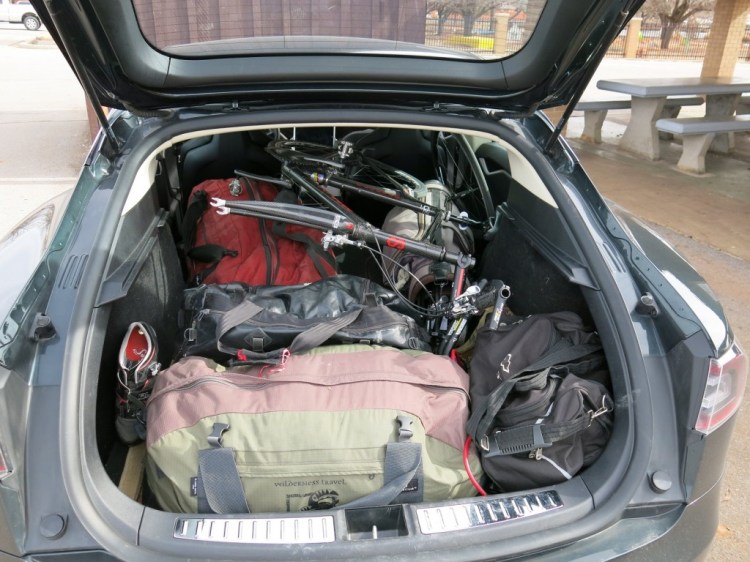After seven days of traveling cross-country in my Tesla Model S electric car — including routes without Supercharger DC fast-charging sites — I had made it as far as Texas.
The trip demanded both forward planning and considerable thought toward contingencies, should conditions not permit the Tesla to go as far as I’d planned on any given leg.
Still, entering my second week, I had made it from New York’s cold, snowy Hudson Valley all the way into the heart of big, flat, warm Texas.
Through this desolate expanse, there are only two intermediate charging possibilities: RV parks in Tucumcari (112 miles) and Santa Rosa (173 miles), New Mexico.
I wanted to see how it went before deciding which one.
Since Oklahoma City, I’ve followed the route of my flight years ago in the Piper Cub, whose primary navigational device was an Esso road map.
I still recall, just west of Amarillo, watching the table-flat farmland below literally fall off a cliff into a sagebrush-littered landscape of buttes and mesas that stretched ahead to the horizon–an instantaneous transition from Midwest to West.
Sure enough, I came to that same magical place along I-40 in the Tesla, though the effect wasn’t quite as spectacular at ground level.
Nevertheless, I felt a sense of exhilaration. Dude, I’ve made it to the Wild West!
Winds were calm and progress was good, so I stretched the recharge stop out to Santa Rosa, which would leave me only 114 miles to my sister’s place in Albuquerque.
I pulled into the RV park with about 40 miles left.
But getting to Albuquerque required a serious climb to more than 7,000 feet, from Santa Rosa’s 4600 feet. So I stayed a full four hours (charging fee: $22) and picked up 120 miles, bringing my total to 160.
If I could squeak to the top of the pass, I could probably coast down and regenerate the last 20 miles and 2,000 feet down to the city. I did.
It was a good reunion with Beck, whom I haven’t seen in a while.
I charged overnight at the nearby Uptown Sheraton, where I’m apparently the first Tesla to use the hotel’s new HPWC. Again, I’m treated like royalty even without staying the night.
Day 9: 539 miles, Albuquerque to Needles, Calif.
Apparently I’ve arrived in Albuquerque on the eve of their worst snowstorm of the year–although by New York standards it barely registers, an inch or two that mostly doesn’t stick.
But I-40, with ice and snow to the west, is reported “challenging.”
Though I’m happy to take on certain challenges, winter driving through remote country is not one of them.
So I hang out with Beck and her neighbors for the day. No regrets; I needed the break.
Next day brings a better forecast, and I set out eagerly toward the warm re-embrace of the Supercharger system, whose arms now reach to Gallup, New Mexico, 141 miles away.
From there I race onward–no more of that 60-mph stuff–to Superchargers in Holbrook, Flagstaff, and Kingman.
The Flagstaff-to-Kingman run prompts memories of perhaps the oddest moment of my Piper Cub flight. At 120 miles, that flight leg was precisely at my maximum range limit for the plane.
Unwilling to shave it that close, I stopped at the only intermediate airport that sold gas, in Williams, Ariz., only 25 miles west of Flagstaff.
I pulled the plane up to the gas truck and topped off my tank–with $2.15 worth of 80-octane aviation fuel. I paid the guy in quarters. He gave me a very funny look.
Back in the Tesla, I made such good time downhill to Kingman that I pushed on to the Supercharger at Needles, arriving well after dark.
One day to go.
Day 10: 344 miles, Needles to Carpinteria, Calif.
Thank God it’s winter, since I remember taking off from Needles in the Cub before dawn with the temperature already at 97 degrees.
Today it’s a pleasant 65 degrees at 8 a.m.
[EDITOR’S NOTE: Needles may be best known as the home of Snoopy the dog’s brother Spike, as recorded by cartoonist Charles Schulz.]
The 144-mile leg across the Mojave Desert to Barstow sucked more juice than I expected. I found out later it was an almost imperceptible climb of about 2,000 feet.
After charging in Barstow at Tesla’s first solar-assisted Supercharger, I continued the climb toward the Supercharger at Ventura.
I eventually topped out at 4,000 feet before descending sharply to the ocean.
At Ventura I encountered something I’d never seen before: all eight Supercharger slots occupied. (Welcome to California.)
The wait for a space was only a few minutes, though, and an hour later I was on my way to Carpinteria, just 30 miles up Highway 101.
My totals: 10 driving days, 3,947 miles, 1,231 kilowatt-hours used, at an average of 312 Watt-hours per mile–and a mere $42 spent on electricity.
It was a fun challenge to get off the Supercharger grid for a while.
I heard a great blues pianist, slept under a pink canopy, saw some really cool old farm implements, and got the inside scoop from a Texas legislator.
None of that would have happened had there been Superchargers all the way.
But heading back in April, I’ll take the I-70 Supercharger route–whose one brief gap I expect to be filled by then.
I’m planning on five days for the trip home to New York, with the prevailing wind at my back all the way.
This story originally appeared on Green Car Reports. Copyright 2015



